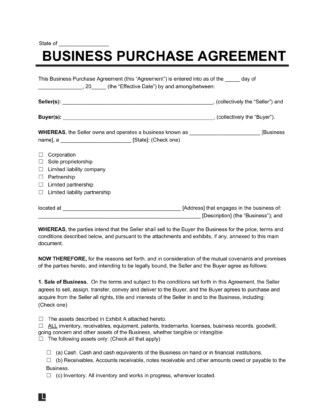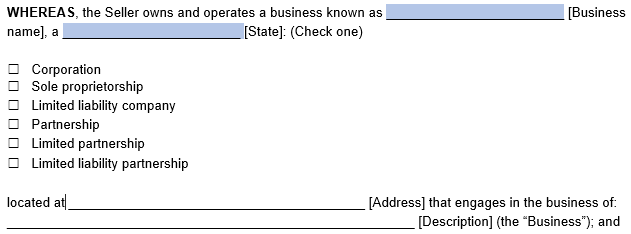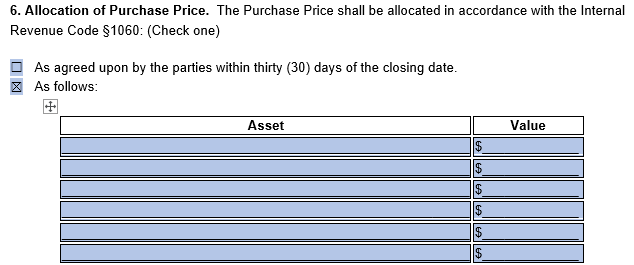
Use our free business purchase agreement to record the sale of a business.

Updated December 8, 2023
Written by Sara Hostelley | Reviewed by Brooke Davis
A business purchase agreement is a legal contract for officially selling any business to another person. It clarifies ownership transfer requirements so the seller can properly relinquish their rights to the business.
This document is also useful for selling some of a company’s assets or shares instead of the entire business entity. In these cases, the document’s author must specify the assets or shares they want to sell.
A business purchase agreement details the provisions for the sale of a company. As a legally enforceable contract, it ensures that both the seller and buyer follow through with their promises and creates an opportunity to confirm the transaction’s terms and conditions.
This business agreement will identify the following essential elements:
Whether you’re buying or selling a business, you can negotiate the sale’s terms and conditions and document the transaction with a business purchase agreement at the closing. A solid negotiation strategy can help you secure an ideal outcome from the business deal.
This agreement allows both parties to prevent the following misunderstandings:
Consult your accountant, attorney, and broker (if any) for the tax, legal, and financial implications of buying or selling a business in your state.
Business purchase agreements typically accompany several supporting documents. Some of the documents you may need include:
Here are some steps you should take to safeguard your arrangement before signing a business purchase agreement:
Request a letter of intent from the other party. This document confirms they’re serious about the transaction. When you know their interest, you can focus on your relationship with them instead of attempting to pursue other buyers.
Obtaining a deposit from the buyer can further ensure their commitment. Establish the parameters for returning some or all of the deposit if the buyer decides not to proceed with the final purchase.
Discuss how you’d like to receive payment for the business. Learn if the buyer will acquire capital funding and from what source so you can determine their ability to follow through with their financial obligations.
While a business sale agreement will have a confidentiality clause, you should establish a confidentiality agreement if the purchase doesn’t occur. This way, the buyer won’t share sensitive information with others as you try to conduct a sale with other parties.
Here’s some legal terminology you may encounter with business sales agreements:
Here are some restrictive clauses you can dictate in a business purchase agreement:
Follow these steps to purchase an existing business:
Find a business for sale that’s worth purchasing. Evaluate its profitability by ensuring it has positive cash flow (or the potential for positive cash flow), a diverse customer base, and a plan for long-term expansion.
Ensure the business is within an industry you’re familiar with. You can also speak with the leaders to better understand if you’d enjoy leading the company.
Some resources you can use to locate a business for sale include:
Perform a formal valuation to better understand the business’s worth. You can complete this step by evaluating its earnings before interest, taxes, depreciation, and amortization (EBITDA), net income, and revenue. You may consider hiring a professional for a more accurate assessment.
Submit a written offer to the seller. Allow them to come back with a counteroffer. From there, you can negotiate the purchase price to settle on one you’re both content with.
As you conduct due diligence, you may present the seller with reasons for a lower purchase price.
Once you’ve negotiated the purchase price, submit a letter of intent to express your interest. While this agreement isn’t legally binding, it can help you show your commitment. As a result, the seller may focus on you as the sole buyer.
A buyer is responsible for conducting due diligence to understand the business’s current state and what they’ll gain if they decide to purchase. Consider reviewing the following documents of the company you want to purchase:
You can purchase a business with a combination of equity and debt, meaning you supply some of the purchase price through your own assets and cover the rest with a loan.
You can obtain a loan like a traditional bank loan or an SBA loan through an outside lender. Alternatively, you can ask about seller financing, where the business owner provides the loan.
If you didn’t discover anything alarming during your due diligence and you secured financing, you can close the transaction. Work with the seller to create a final business purchase agreement and sign the document. At this point, you can follow the document’s guidelines for receiving company ownership.
Here’s a step-by-step on creating a business purchase agreement with a free business purchase agreement template.
A business purchase agreement should detail the buyers’ and sellers’ names.
It must also include information about the business the seller is selling, such as its name, location, description, and entity type.

The business purchase agreement will identify the specific assets transferred in the sale.
These assets include physical assets such as vehicles, real estate, or furnishings and financial assets such as accounts receivable. It may also include intangible assets such as the business name, trademarks, patents, goodwill, and customer lists.
You will also want to include excluded assets you do not wish to include in the sale.

A business purchase agreement should cover whether the buyer assumes any liability by purchasing the business. Liabilities may include accounts payable, environmental liabilities, employee-related expenses, lawsuits, and contractual obligations.

If you need to, you can also detail excluded liabilities, which are explicitly not included in the sale.

One of the critical elements in a business purchase agreement is the purchase price. Here, you should detail how much the buyer will pay to the seller for the purchase of the business and if the buyer will pay a deposit.

You should also include the allocation of the purchase price among the assets in the agreement. The allocation affects the deal’s financial structure, tax consequences, and financial reporting.
 allocation of purchase price" width="634" height="265" />
allocation of purchase price" width="634" height="265" />
Another element of the purchase price is purchase price adjustments. This section covers whether the parties will adjust the purchase price at closing to account for any differences in the business between the time of signing the agreement and the closing date.
It also covers any changes to the company’s value the buyer assumes, such as specific net working capital or fair market value.
The terms of a business purchase agreement take up the bulk of the contract and consist of important information like:
Obtain signatures from the buyer and seller or their representatives to make the agreement legally binding. Depending on your jurisdiction, a notary public may need to witness their signatures.

Download a business purchase agreement template as a PDF or Word file below: